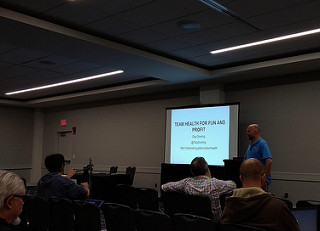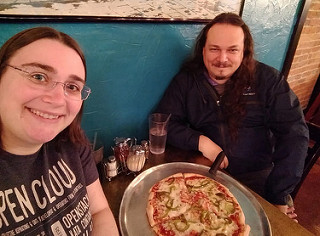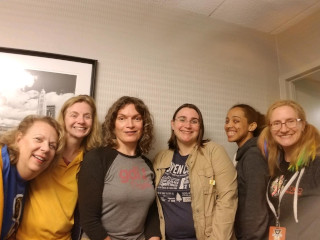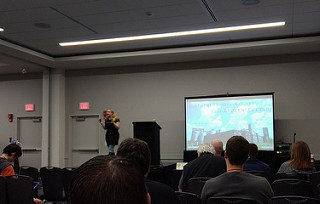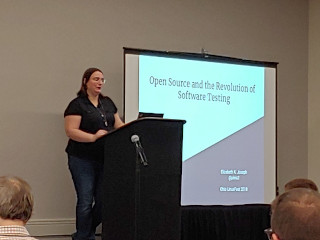At the beginning of October I flew out to Columbus, Ohio for the annual Ohio LinuxFest. I spoke there in 2016, so I was delighted when I was invited back this year not just to speak, but to deliver the closing keynote.
The two-day event began on Friday, October 12th with a series of paid training workshops, and then a single conference track. I made my way to the single track for the day, where the first talk was by Clay Dowling on Team Happiness for Fun and Profit. His talk poked around some of the highlighted stereotypical perks offered by a lot of tech companies, but implored us to think more deeply than that. Is it beer and ping pong that keeps tech workers engaged? Probably not, and some statistics show that as many as 57% of tech workers report suffering burnout. Being mindful to craft a healthy work-life balance and asking the right questions of your team about what could be improved were key points in his talk.
It caused me to reflect some on the strategy of many startups to hire young people who don’t have the experience to avoid burnout, and one of the insightful things he mentioned when I asked was that he struggled to connect with non-tech people when he was working too much in his 20s, and that the “user” often became the enemy in the eyes of the development team. Of course there are many reasons to hire more senior talent (not the least of which because they can do more work in 40 hours a week simply due to experience than most junior developers can in 60), but a team that is struggling to connect with the users will certainly struggle to be effective. He continued his line of thinking in a talk later in the day titled Getting to Done Faster where he encouraged the audience to not avoid problems (instead, address them), relentlessly remove barriers to deploy frequently, and accept that as carefully as you plan, plans will change and failures will occur, you need to be prepared for that. I can see how health of a team and trust plays heavily into all of this, even further building up the business case for making sure your staff is healthy and being treated fairly.
I also enjoyed hearing from Jim Kittle about the status of a migration away from a monolithic infrastructure at Ohio State and onto a platform using Puppet, Kubernetes, GitLab and Jenkins, among others. These breaking-up-the-monolith talks are always interesting. It seems that a lot of organizations are slow to migrate to microservices simply because the project seems so huge. Talks like this one from Jim remind us that most organizations tackle this incrementally, which is something that microservices are well-suited for. Start with greenfield projects, or your stateless workloads, you can still call into legacy back-ends or tackle the more complicated components later. Modernizing even parts of your infrastructure today will bring value, and attract talented people who are more inclined to help build and maintain a more modern stack.
The other speaker on Friday who really stood out for me was Joel Graff, who gave a talk titled Engineering, Open Sourced. He quickly had to explain to the audience that he wasn’t talking about software engineering, but traditional engineering, where people build things like bridges. His talk began with a look at FreeCAD and the latest advances of the project and interesting projects that were using it (see the FreeCAD Users Showcase for some of this).
Then he pivoted to talk about the vital importance of open source on the field of engineering, which is where the talk became a standout one for me. As folks working in tech, we’re familiar with the reasons to avoid vendor lock-in and are great at discussing it at length in our field, but I always find it fascinating when it starts being applied to other disciplines that technology touches. He talked about the risks of government specifications that require reliance on proprietary formats, some of which require very expensive software that effectively excludes those without the means to purchase it, but worse relies upon the vendor to continue supporting the format. Consider what happens in 40 years when the bridge forms a crack, but the original plans are locked inside a proprietary format that no one has the ability to open anymore? He also touched upon the dangers of machine learning and other tooling that takes input and delivers and answer that the engineers working on rely upon, but are unable to fact check. We really have to own these tools for the long-term physical safety of our world.
When the first day wrapped up I met up with my friend David for a walk before making our way over to a pizzeria where just two years before we enjoyed with a couple friends from the Ubuntu community, Nathan and Jose. I admit, it’s not the amazing flat pizza of the northeast, but it was still better than the pizza I get in California. Good meal, I’m glad we went back.
After dinner, I popped back over for the tail end of a Birds of a Feather session with folks talking about the Linux Users Group (LUG) in western Pennsylvania, which borders Ohio. They seemed to be looking at the future of the group, but noted that LUGs have declined in recent years. My view into this phenomenon is that, as much as I still love it, Linux has become so ubiquitous that it’s largely not interesting enough for most people to have dedicated meetings for anymore. We instead have groups for software that builds upon Linux servers by default, and largely take it for granted until something goes wrong. I do have to admit that it’s still a bit sad to leave that time behind, and I do still enjoy hearing about LUGs that are thriving in spite of it.
From there I joined several other women at the conference for a late ice cream-fueled women in tech gathering. The Ohio LinuxFest is quite lean on diversity across the board (something it appears they do try to address when doing speaker selection, and now with a Code of Conduct), so it was nice to have a time and space to connect with a handful of the other women who were attending.
The second day of the conference is a much larger affair. Keynotes! Multiple tracks! The opening keynote came from Bridget Kromhout of Microsoft on Containers will not fix your broken culture (and other hard truths). In this humorous, but informative talk, she shed light upon some of the behaviors and challenges that organizations have, that can’t be fixed with technology. A video of her talk is available here, and if reading is more your speed, a similar version was published in ACM Queue several months ago Containers Will Not Fix Your Broken Culture (and Other Hard Truths).
I attended a few other talks throughout the day, but as often the case with these events, the connections I make with people in the community are the most valuable. I was able to take time to chat with several folks both in the local community and more broadly. I also found myself having to swap out a continuous delivery demo for an upcoming conference, so getting to meet up with Jason Plum from GitLab to chat about Auto DevOps helped tremendously given the limited time window I had to prepare.
The conference concluded with the keynote I had prepared on Open Source and the Revolution of Software Testing. One of the things I learned as I’ve read back into some of the history of software development is how tightly coupled software testing has always been in the process. This is in stark contrast with what I experienced in the open source world. For a very long time, if software testing was done at all, it was done privately. It was done either inside companies that used the software and then reported back upstream (hopefully!) with tidbits of findings in the form of bug reports and patches or just some checks that the maintainer would run on their own local system before approving code changes. Systematic, public testing is really something new for open source, but since we’ve started seeing it, the move for projects to adopt it has been swift and the open source and proprietary tooling available to support the workflow has grown tremendously. My keynote covered this journey, and explored some of the options out there for testing your own open source project, and highlighted the benefits of using open source software testing tooling for your open source projects. A video of the talk can be seen here and I’ve uploaded a PDF of the slides here
More photos from the event here: https://www.flickr.com/photos/pleia2/albums/72157674943511988/
Huge thanks to the organizers of the Ohio LinuxFest. They put a tremendous amount of work into this conference and their kindness and support for speakers is commendable. It may be a couple years before I go back just because of some changes in my life, but it is one I’d recommend folks near Ohio submit to, It’s an interesting mix of hobbyists and professionals working for a vast spectrum of organizations.


